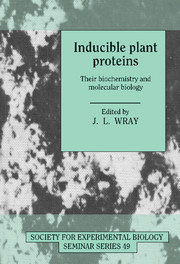Book contents
- Frontmatter
- Contents
- List of Contributors
- Preface
- Metal-binding proteins and metal-regulated gene expression in higher plants
- Phosphate starvation inducible enzymes and proteins in higher plants
- Nitrate reduction in higher plants: molecular approaches to function and regulation
- Inducibility of the glutamine synthetase gene family in Phaseolus vulgaris L.
- Expression and manipulation of genes involved in phenylpropanoid biosynthesis
- Biochemistry and molecular biology of CAM
- ABA- and GA-responsive gene expression
- Regulation of gene expression, ethylene synthesis and ripening in transgenic tomatoes
- Induction of nodulin genes and root nodule symbiosis
- Systemic acquired resistance: an inducible defence mechanism in plants
- Biochemistry and molecular biology of the anaerobic response
- The heat shock response in transgenic plants: the use of chimaeric heat shock genes
- Biochemistry and molecular biology of cold-inducible enzymes and proteins in higher plants
- GBF-1, GBF-2 and GBF-3: three Arabidopsis b-Zip proteins that interact with the light-regulated rbcS-1A promoter
- Index
Regulation of gene expression, ethylene synthesis and ripening in transgenic tomatoes
Published online by Cambridge University Press: 06 July 2010
- Frontmatter
- Contents
- List of Contributors
- Preface
- Metal-binding proteins and metal-regulated gene expression in higher plants
- Phosphate starvation inducible enzymes and proteins in higher plants
- Nitrate reduction in higher plants: molecular approaches to function and regulation
- Inducibility of the glutamine synthetase gene family in Phaseolus vulgaris L.
- Expression and manipulation of genes involved in phenylpropanoid biosynthesis
- Biochemistry and molecular biology of CAM
- ABA- and GA-responsive gene expression
- Regulation of gene expression, ethylene synthesis and ripening in transgenic tomatoes
- Induction of nodulin genes and root nodule symbiosis
- Systemic acquired resistance: an inducible defence mechanism in plants
- Biochemistry and molecular biology of the anaerobic response
- The heat shock response in transgenic plants: the use of chimaeric heat shock genes
- Biochemistry and molecular biology of cold-inducible enzymes and proteins in higher plants
- GBF-1, GBF-2 and GBF-3: three Arabidopsis b-Zip proteins that interact with the light-regulated rbcS-1A promoter
- Index
Summary
Introduction
The alterations in colour, flavour, texture and aroma that are responsible for transforming an unripe, unpalatable fruit into one that is attractive to a consumer are known collectively as ripening. These ripening changes are catalysed by specific enzymes that cause biochemical modifications required for the ripening process to occur (Tucker & Grierson, 1987). In various fruits, different biochemical pathways have been recruited to the ripening programme during the course of evolution, accounting for the molecular, cellular, and anatomical differences between the many different species that produce fleshy fruits. Thus some fruits undergo no colour change (e.g. kiwi fruit), whereas in others the change in colour may occur in surface layers (e.g. some apples) or throughout the flesh (e.g. tomato). Different mechanisms operate for achieving the same ends, with generation of colour occurring either by the accumulation of carotenoids in chromoplasts (e.g. tomato, banana), anthocyanins in vacuoles (e.g. strawberry, blackcurrant), or the generation of special structures for thin-film interference of light, as in Elaeocarpus (Lee, 1991). During the onset of ripening, in addition to the generation of new structures and compounds, some existing ones such as chloroplast thylakoids and starch grains disappear. These changes are sometimes related to colour production. However, solubilisation of starch and cell walls contributes also to alterations in texture, taste, and juiciness. Further biochemical processes generate a balance of various organic acids and sugars and also produce aromatic compounds which confer a distinctive flavour and aroma to particular fruits.
- Type
- Chapter
- Information
- Inducible Plant ProteinsTheir Biochemistry and Molecular Biology, pp. 155 - 174Publisher: Cambridge University PressPrint publication year: 1992
- 4
- Cited by



